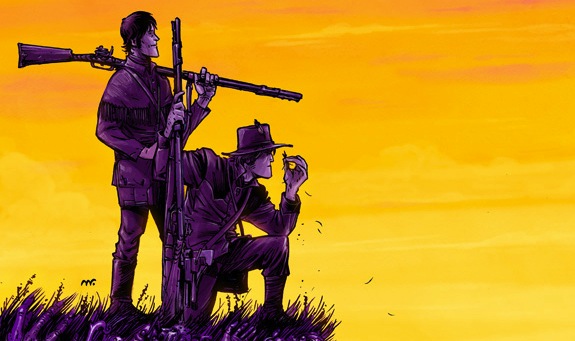(NOTE: The following announcement can be found in full here.)
Sacred Texts and Comics: Religion, Faith, and Graphic Narratives
Edited by Ken Koltun-Fromm and Assaf Gamzou
Proposed volume for the “Critical Approaches to Comics Artists” series, University Press of Mississippi
In addition: Symposium on “Sacred Texts and Comics” at Haverford College, May 5th and 6th, 2016 (workshops for contributors to this proposed volume are included) |
 The last decade has produced critical and expressive studies in sacred canonical texts and comics. Witness, for example, the artistic works from R. Crumb’s The Book of Genesis (2009) and JT Waldman’s Megillat Esther (2005), as well as scholarly publications from Karline McLain’s India’s Immortal Comic Books (2009), A. David Lewis’s edited volume Graven Images: Religion in Comic Books & Graphic Novels (2010), and Samantha Baskind’s and Ranen Omer-Sherman’s editorial work for The Jewish Graphic Novel: Critical Approaches (2010).
The last decade has produced critical and expressive studies in sacred canonical texts and comics. Witness, for example, the artistic works from R. Crumb’s The Book of Genesis (2009) and JT Waldman’s Megillat Esther (2005), as well as scholarly publications from Karline McLain’s India’s Immortal Comic Books (2009), A. David Lewis’s edited volume Graven Images: Religion in Comic Books & Graphic Novels (2010), and Samantha Baskind’s and Ranen Omer-Sherman’s editorial work for The Jewish Graphic Novel: Critical Approaches (2010).
Sacred Texts and Comics: Religion, Faith, and Graphic Narratives is a proposed volume for the “Critical Approaches to Comics Artists” series at the University Press of Mississippi that builds upon, but also beyond, Western or “major” religious traditions to develop a broader landscape of religious graphic mediums. We encourage submissions that engage Islamic, Jewish, Christian, Hindu, Buddhist, Native American, African Diaspora traditions, or other religious communities from a variety of disciplinary or cross-disciplinary perspectives. Such critical approaches may include studies in religion, literature, theology, art history, culture, anthropology, political science, or other disciplines that work with the multi-dimensional features of graphic narratives.
Topics may include, but are not limited to:
- Depictions of the sacred in comics.
- The place of historical exegesis and critical, religious interpretation in graphic narratives.
- Comics as a form and method of interpretation.
- The ways in which the graphic, formal features engage notions of the sacred.
- The modes by which graphic narratives represent the sacred or conceptions of religion.
- The ways in which religious identity and belief are represented and explored in graphic mediums.
- The multiple ways that visual culture informs religious practice.
Please send a 500-1000 word abstract, CV, and contact information to Ken Koltun-Fromm (kkoltunf@haverford.edu) and Assaf Gamzou (assaf@cartoon.org.il) by August 21, 2015.
Haverford College will host a symposium on “Sacred Texts and Comics” on May 5th and 6th, 2016 that will include workshops for contributors to this proposed volume. Please indicate your interest in and availability to participate in the symposium (all expenses will be paid, including a small stipend).
 Concurrent with this year’s New York Comic-Con, a “Comics and the Jews” panel was hosted at the Center for Jewish History’s auditorium by the American Jewish Historical Society, Forward magazine reports. The discussion featured Karen Green of Columbia University, Paul Kupperberg formerly of DC Comics, From Krakow to Krypton: Jews and Comic Books‘s Arie Kaplan, Danny Fingeroth formerly of Marvel Comics and author of Dressed as Clark Kent, and former publisher of DC Comics Paul Levitz. The familiar origins of American comics as a urban Jewish product were recounted, as was a compelling intercultural anecdote:
Concurrent with this year’s New York Comic-Con, a “Comics and the Jews” panel was hosted at the Center for Jewish History’s auditorium by the American Jewish Historical Society, Forward magazine reports. The discussion featured Karen Green of Columbia University, Paul Kupperberg formerly of DC Comics, From Krakow to Krypton: Jews and Comic Books‘s Arie Kaplan, Danny Fingeroth formerly of Marvel Comics and author of Dressed as Clark Kent, and former publisher of DC Comics Paul Levitz. The familiar origins of American comics as a urban Jewish product were recounted, as was a compelling intercultural anecdote: The latest issue of the Studies in Comics journal from UK-based publisher Intellect features an article by
The latest issue of the Studies in Comics journal from UK-based publisher Intellect features an article by 

